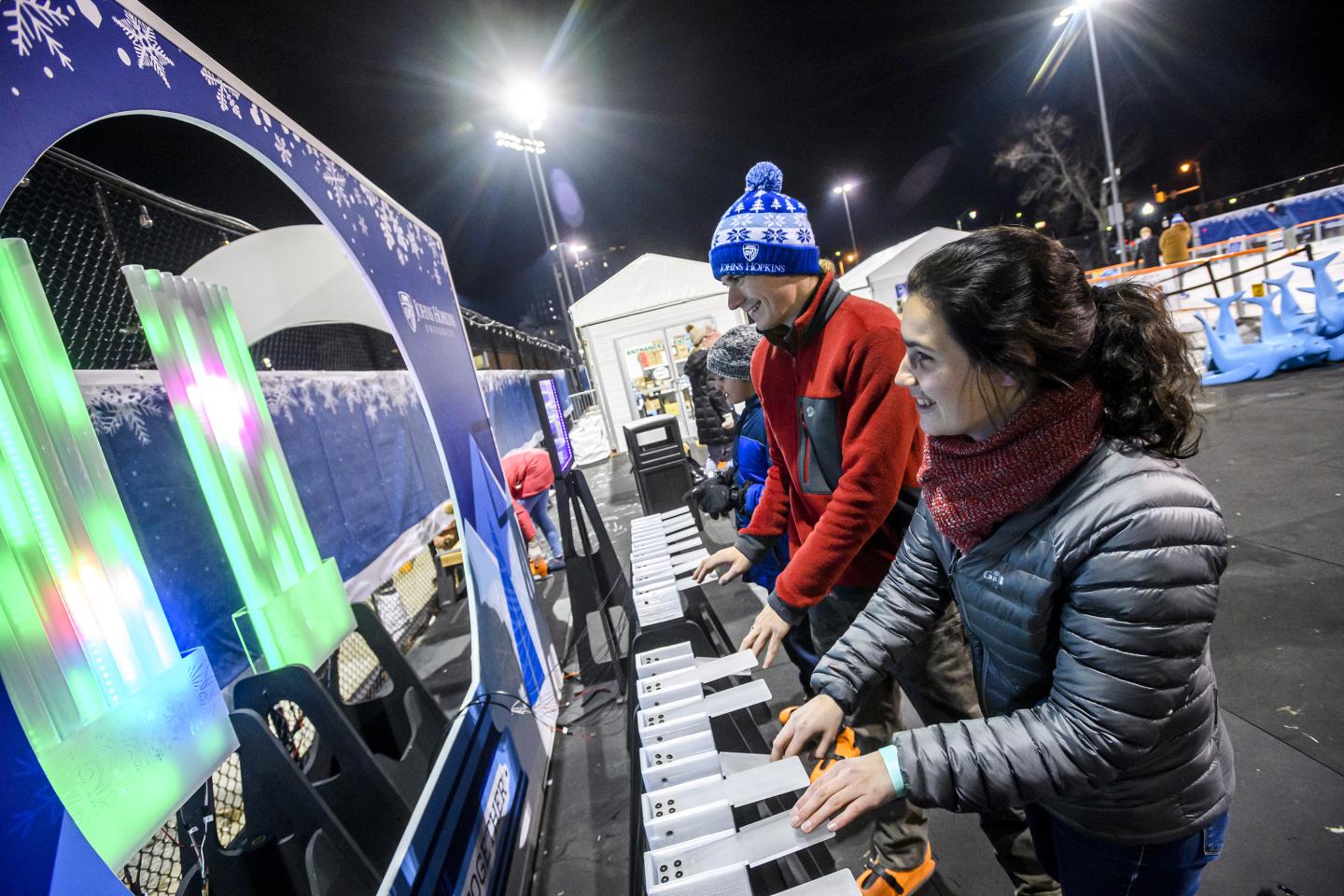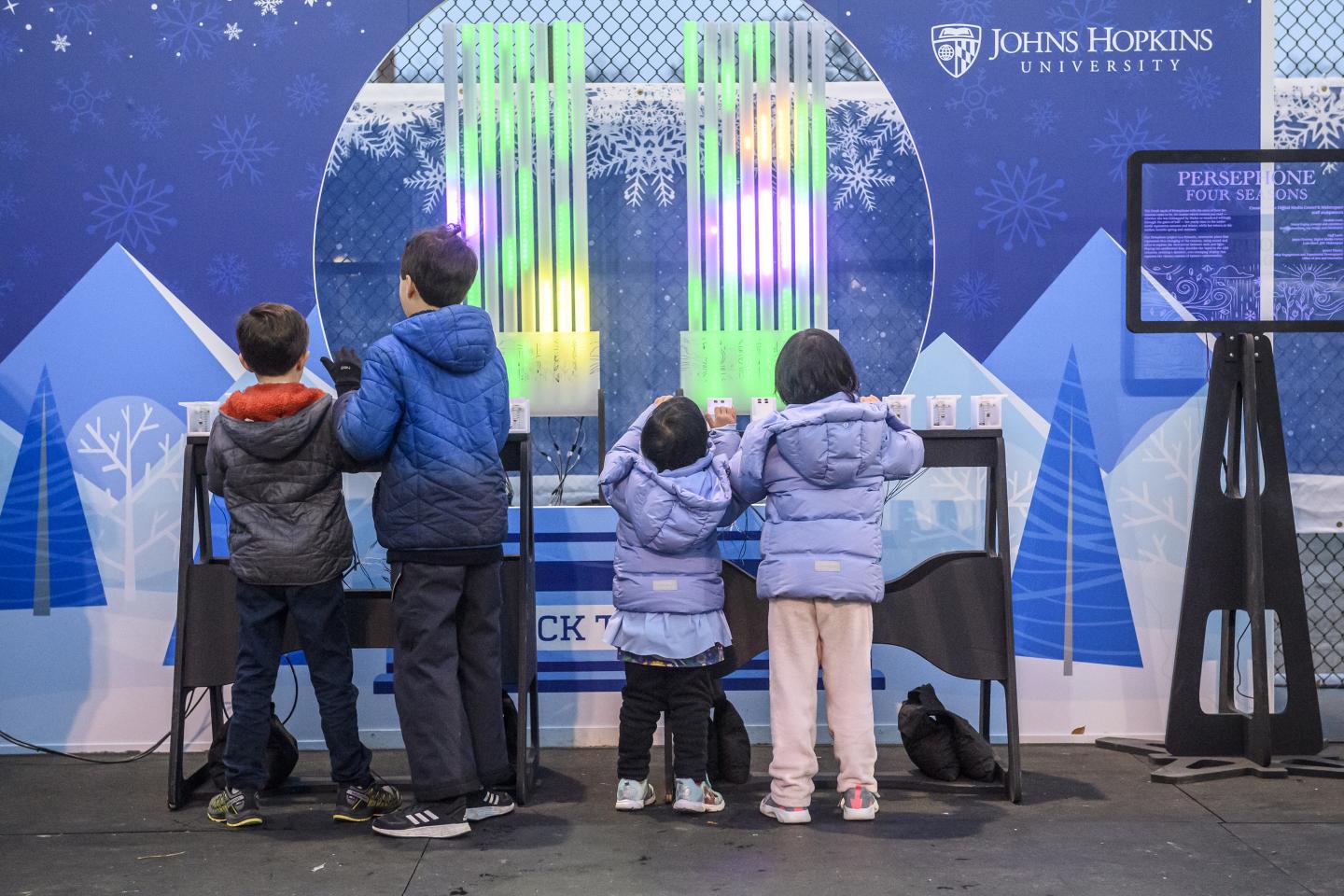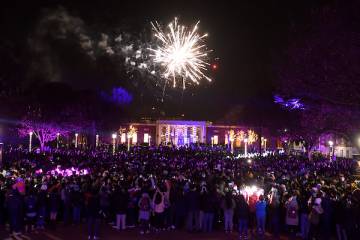The Lighting of the Quads and the annual pop-up ice rink bring extra sparkle to the Homewood campus during the darkness of late fall and winter, but this year both events provided some extra wattage, thanks to Persephone: Four Seasons, a fully interactive light and sound organ created by Johns Hopkins University staff and students.
The first-ever collaboration between the Digital Media Center and the Makerspace, Persephone is the result of a semester-long shared project led by Jason Charney, a composer, sound artist, and multimedia specialist for the DMC, and Luke Ikard, a multidisciplinary visual artist and manager of the Makerspace.
Video credit: Aubrey Morse/JHU
As active members of Baltimore's arts scene, Charney and Ikard were aware of each other's work before they became Hopkins colleagues. Ikard, who joined the university in January 2022 to oversee the Makerspace's reopening after a two-year pandemic pause, was drawn to the role for its synthesis with his woodworking and sculpture practice. Ikard's arrival motivated Charney, who has been with the DMC for nearly three years, to propose a collaborative project to establish an official connection between their offices.
"In the past, the DMC did some design-and-build installations for the Lighting of the Quads using our own makerspace facilities in the Mattin Center, before we moved to our new location on Charles Street," Charney says. "Knowing that Luke was at the JHU Makerspace, revitalizing it after COVID, I thought it was natural for our departments to have some synergy and that a project-oriented collaboration was the way to start."
Adds Ikard: "And it was mutually beneficial for the Makerspace because the DMC's very much established in the minds of the student body. So to work together to let them know about our additional resources seemed natural."
Although operated by two separate divisions of the university—the DMC is a department of the Office of Arts and Innovation within Student Affairs while the Makerspace is part of the Whiting School of Engineering—the two spaces offer many complimentary services and are popular with students.

Image credit: Will Kirk / Johns Hopkins University
"Since I am a Makerspace employee, I use their services quite frequently, especially their 3D printing," says Seth Jayawardane, a sophomore Makerspace technician majoring in chemical and biomolecular engineering. "I also frequently use the DMC for their photography printing and rental services, specifically to rent projectors and A/V equipment."
Jayawardane is one of the three students who helped Charney and Ikard to shepherd the Persephone project from concept to testing to reality, along with Naina Gupta, a first-year computer engineering student, and Mac Millan, a sophomore majoring in computer engineering. Additional student staffers at the Makerspace and the DMC also contributed at various points along the way.
"I got involved with the Makerspace after hearing about this project, but I am planning on being more active there this semester," Millan says. "It's been a blast working on a project helmed by a great team. Jason, Seth, Naina, and Luke all did amazing work planning and executing this project."
After an open information session at the beginning of the fall semester, the team was formed and work began in earnest, meeting weekly right up until the Lighting of the Quads.
"For our first meeting, both Jason and I put together some examples from contemporary artists who work with light and sound and presented them to the students to start the discussion and get the creative juices flowing," Ikard says.
Taking cues from the clavier à lumières ("keyboard with lights") invented by early 20th-century Russian composer Alexander Scriabin for his piece Prometheus: Poem of Fire, the concept was finalized for an interactive synthesizer resembling a pipe organ that would produce columns of LED images to correspond with the sounds of each key. With further inspiration from the myth of Persephone and the changing of the seasons, the LED colors and musical modes evolve as the instrument is played, resulting in an ever-changing combination of sights and sonorities.

Image credit: Will Kirk / Johns Hopkins University
"It's all pretty much software controlled on one computer that is triggering all the sounds with Ableton Live," Charney explains. "Then that triggers animations that are sent out to the LEDs through a program called TouchDesigner. The keys are actually just completing these circuits when you press them down through a circuit board called Arduino."
"Jason led the technology aspect of the project," Ikard says. "Then once we had that core idea down, we worked with the students to develop what the physical structure would look like and how we wanted users to interact with it. And that's where the Makerspace shines; we have larger prototype manufacturing equipment that can produce on this scale. We used our woodshop, and we used our CNC router, which could import our two-dimensional designs and cut them perfectly out of plywood. Being able to design that kind of custom object is what we excel at."
"I focused on design and manufacturing for the Persephone project," Jayawardane says. "Specifically, the keys for the project were all custom designed through iterative prototyping. I designed them to be primarily 3D printed out of two commonly used 3D printing materials, PETG and TPU. I aided in finishing the wooden stands and LED tubes for the project as well."
"I arrived somewhat later in the design process," says Millan. "Since I'm in electrical and computer engineering, I worked on wiring the thing up and did some on-the-spot wire juggling during Lighting of the Quads."
At the December event, as members of the Hopkins community tried their hands at playing Persephone for the first time, the astonished looks and joyful reactions were proof that this first DMC/Makerspace co-production was a success.
"Overall, the response has been great," Jayawardane says. "Initially, the reaction is awe due to the LED lights and the intuitive interface. Once they start playing, they usually collaborate with other friends to try and make a good beat. Within a set period, the 'season' changes the pattern and color of the LED lights, which usually makes them try out new sounds and patterns. Also, the keys are designed to take a large amount of abuse; therefore, many people love to smash them."
Since its debut at the Lighting of the Quads, the light organ was brought out a second time for a special evening at the Johns Hopkins ice rink on Feb. 7, and will be deployed again for the Alumni Weekend Arts Showcase on April 14.
Charney and Ikard hope that this will be the first of many joint ventures.
"It would be cool to do another project like this with the lessons we learned about managing this one," Charney says.
"There's a lot of enthusiasm about it," Ikard adds. "I've already seen some of the students who were involved this year talking about the next event. I think it's definitely something we'll keep going."
Posted in Arts+Culture, Student Life









